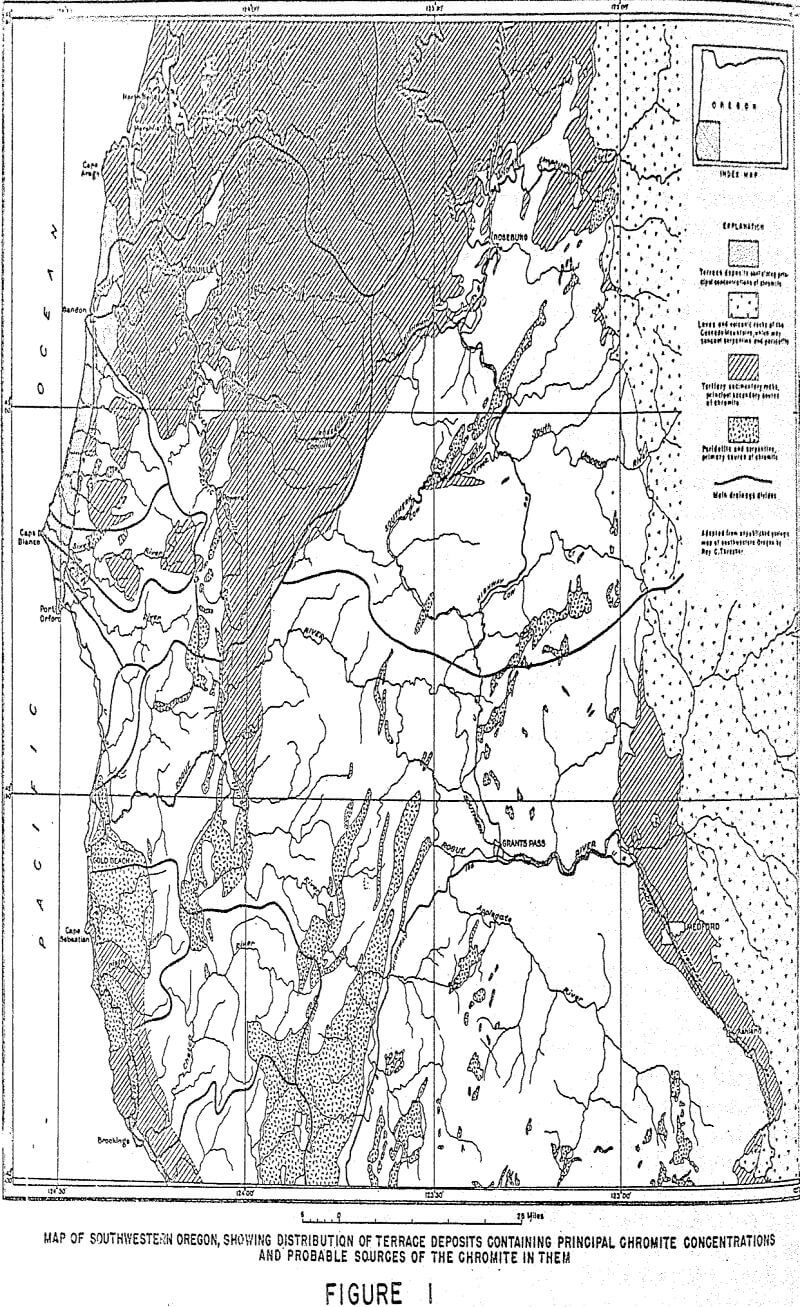Table of Contents
The author describes the actual processing of the government stockpile of chromiferous sands located at COQUILLE, OREGON, during 1955 and 1956. A general history of the stockpile is given, along with a background of the geology and origin of these sands. The flow sheet used in this operation is outlined in detail, and the minerals won from the stockpile by high tension and magnetic processing are discussed as to their purity and saleability. Among these minerals are chromite, ilmenite, magnetite, zircon, garnet, rutile, monazite, gold, and platinum. Planned post-stockpile operations on the present beach deposits are discussed.
Flowsheet
The stockpile ore is brought into the screening and washing plant by means of a mucker dragline, using a ¾ yard crescent bucket which dumps the ore through a grizzley into a hopper. By means of a screw in the bottom of the hopper, the ore is conveyed to a poidometer automatic weighing machine for ore tonnage records. At this same point, the ore is automatically sampled for analyses and moisture determinations. After weighing, the poidometer delivers the ore to a bucket elevator feeding a wet vibrating 20 mesh screen which breaks up ore conglomerates and removes foreign waste material. The screen underage flows into the sump of a wilfley sand pump which pumps the slurry to a dewatering cone, the underage from which drops into a dewatering screw (the cone is not shown in the flow sheet).
The sand emerges from the dryer at around 300° F., dropping into the boot of a chain elevator which delivers it to a 100 ton dry, heavy sand, storage tank. Flowing from the bottom of this tank, the hot sand is fed by means of an elevator through a distributor box to a Carpco High Tension Separator System, consisting of eight rotors. This machine separates the conductor minerals, consisting of chromite, magnetite, ilmenite, rutile, gold, and platinum, from the nonconductor minerals, consisting of zircon, garnet, and quartz, by a high voltage discharge the conductor minerals are thrown from the spinning rotors, and are called the “thrown fraction.” the nonconductor
minerals are pinned to the spinning rotors and have to be brushed off. These nonconductors are called the “pinned fraction.”
The minerals in the thrown fraction are then collected by a system of conveyors and elevators and passed over a permanent magnetic pulley, which pulls out saleable magnetite, the remainder of this fraction then passes through an induced roll exolon magnetic separator which pulls out the ilmenite as a saleable product, pulls out the semiconcentrated chromite and passes through the nonmagnetic rutile and gold fraction.
Likewise, the minerals in the pinned fraction are collected and passed directly through another induced roll exolon Magnetic Separator, which pulls out the trapped conductors which, in turn, are conveyed back to the head feed of the 8 rotor Carpco machine.
Principle of Operation of the Carpco High Tension Separator
The high tension (or electrodynamics) separator separates one mineral from another by the difference in electrical conductivity of the minerals; whereas a magnetic separator separates minerals because of their differences in magnetic susceptibility.
High tension separation should not be confused with electrostatic separation. An actual electrical current flow takes place in a high tension separator in the form of a corona discharge which places an electrical charge on the mineral particles being processed. In an electrostatic separator, the minerals must be electrically charged in some manner or other before entering the separation system. Having been charged, the mass of minerals are then passed between positive and negative electrodes, the positively charged particles being deflected toward the negative electrode and the negatively charged particles being deflected or attracted toward the positive electrode.
Discussion of Mineral Values and Saleability
The Coquille Plant, which cost in the neighborhood of $300, 000, including clearing of the plant site, buildings, equipment and all, averaged around 175 tons per day of stockpile feed, after breaking in.
From this feed were produced 80 to 90 tons of chromite per day, assaying 42% to 43% Cr2O3, with a Cr-Fe ratio of around 1.5 : 1.0. All this beneficiated chromite was shipped in bulk railroad cars (either hoppers or gondolas) to the Spokane Plant of Pacific Northwest Alloys, where it was processed into vacuum produced ferrochromium alloy.
Metallurgical specifications for chromite in the past have called for ores high in Cr2O3 and a Cr-Fe ratio of 2:1 or better. This Oregon chromite is considered low grade metallurgically however, the PNA process made use of it quite satisfactorily.



